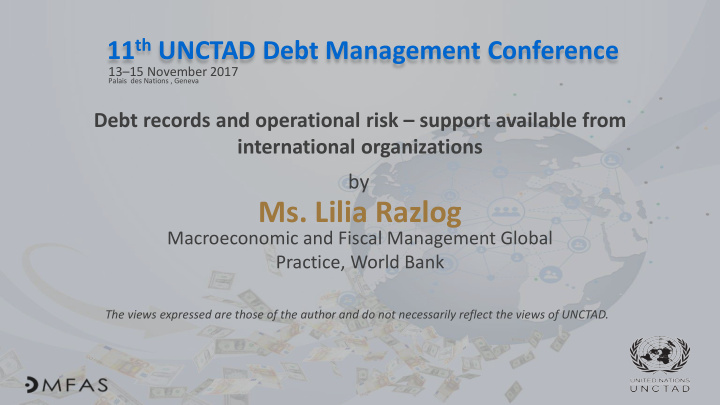



11 th UNCTAD Debt Management Conference 13 – 15 November 2017 Palais des Nations , Geneva Debt records and operational risk – support available from international organizations by Ms. Lilia Razlog Macroeconomic and Fiscal Management Global Practice, World Bank The views expressed are those of the author and do not necessarily reflect the views of UNCTAD.
World Bank Group Government Debt and Operational risk management Lilia Razlog World Bank November 2017 UNCTAD
Overview 1. Increasing complexity of public debt management 2. Operational risks in the DMO 3. How to manage risks: Debt Management Facility TF
Public debt has increased in recent years across all regions, with MNA and SSA standing out 3
Among IDA countries, commodity exporters and post-HIPCs showed strong increases... 4
…with two -thirds of IDA countries seeing an increase over the past decade 5
The increase was driven primarily by domestic debt, but external debt also rose Low income HIPC Commodity Small States Low income HIPC Commodity Small States Exporters (IDA) (IDA) Exporters (IDA) (IDA) 6
Rising portfolio inflows to EMs despite falling sovereign ratings suggest that market demand may not be driven by fundamentals but by search for yield...
Government Debt management as complex as ever A key task of the DMO is the management of risks inherent in the public debt portfolio. Risk management involves being able to identify, measure, monitor and mitigate or control each category of risk. How much to finance: Take into How to finance account initial What to finance: (choice of conditions (debt Choose feasible instruments): MTDS situation), the global projects with the cost/risk trade offs; environment highest social return look into macro (volatility) and the ( Public Investment implications of country’s Management ) alternative debt repayment capacity instruments in the short and medium term ( DSA ) Successful fulfilment of such tasks requires a consolidated debt database and risk assessment tools
Quality of government debt management requires reforms: 112 DeMPAs conducted between 2007-16 78 countries across 6 regions 100% 80% N/R, N/A 60% D C 40% B A 20% 0% AFR EAP ECA LAC MNA SAR Total 9
Comparison of debt management performance over medium time
22% DEBT REPORTING 45% Performance tracking for each area of reforms DEBT RECORDS 15% DeMPA results: scores C and higher by Debt Management categories SEGREGATION OF DUTIES, STAFF CAPACITY AND BCP 22% DEBT ADMINISTRATION AND DATA SECURITY 24% CASH FLOW FORECASTING AND CASH BALANCE MANAGEMENT 19% LOAN GUARANTEES, ON LENDING DERIVATIVES 34% EXTERNAL BORROWING 43% DOMESTIC BORROWING 64% COORDINATION WITH MONETARY POLICY 61% COORDINATION WITH FISCAL POLICY 11% AUDIT 45% EVALUATION OF DEBT MANAGEMENT OPERATIONS 22% DEBT MANAGEMENT STRATEGY 60% MANAGERIAL STRUCTURE 54% LEGAL FRAMEWORK 100% 80% 60% 40% 20% 0%
Operational Risk – examples of threats • Infrastructure and Technology failures • Incidents where access to premises is denied • Key service providers of resource failure dependences • Staff management and related human failures • Failure to meet statutory, human, legal resources and other obligations • Major regional or natural disasters
Operational risk can be managed and mitigated, but it cannot be eliminated entirely • Operational risk tends to increase with the complexity of operations • Operational risk accompanies all debt management activities • A mitigation for one aspect of operational risk may increase other aspects Operational Risk Operational risk Front Office Middle Office Back Office Complexity of operations Focus in the first instance on reducing the high-impact, high- likelihood aspects of operational risk But still manage the other aspects
The Debt Management Facility (DMF) Strengthening debt management capacity DMF Program and institutions Principles and through a number of Products tools that help Governance countries assess and Partnership plan their debt management 14
DMF II: TA and Products Debt Domestic Debt Management Market Reform Plans Development Medium term Debt Manager’s debt management Practitioners strategy Program (MTDS) Debt Managers Subnational Network Debt Peer-2-Peer Management interaction Trainings Online DeMPA Face-2-face Objective: Strengthen Capacity Principles : DMF- Global Programmatic DSA Knowledge Approach Demand Driven
DMF - Program Implementation to date
Strategic direction – continue to help and expand
Debt Management Facility (DMF) - Partnership Missions to Missions to Missions to Mission to Missions to Rwanda, Congo, Rwanda, Kyrgyz Republic, Activities in Nicaragua; Nigeria, Liberia, Dem. Rep., Joint Implementation of the Zimbabwe, Togo, Niger, Franco-phone Sierra Leone, Tajikistan, Program MTDS Training in Uganda, Kenya, Papua New Africa Gambia Zimbabwe, Togo, Mexico Zambia Guinea other A Global Partnership in Action ICG progress Report – Page 18
DMF II – Partnership - Donors AfDB … .
Conclusions Sustainability of results - Focusing support for debt management reforms’ implementation along with broader PFM reforms - Providing programmatic assistance to eligible countries for the medium to long term - Maintaining integrity and quality of DMF TA - Keeping in mind that key factors for successful debt management are based on macroeconomic stability and fiscal discipline
Debt Management Facility www.dmfacility.org http://www.worldbank.org/en/topic/debt DMF News: https://www.dmfacility.org/newsletters
Recommend
More recommend